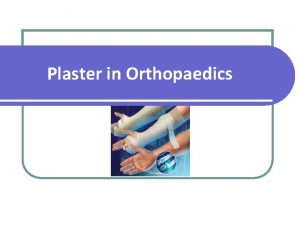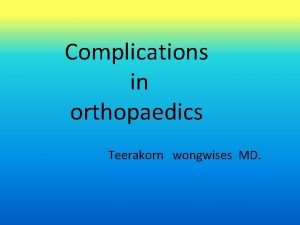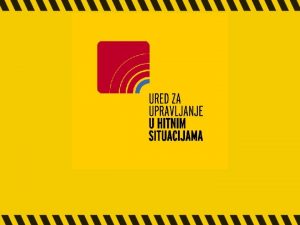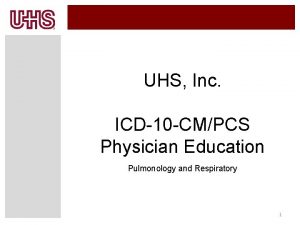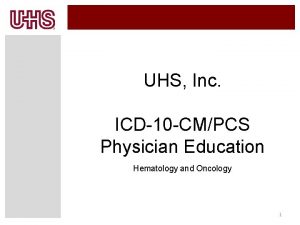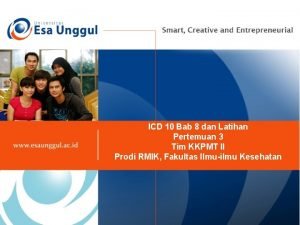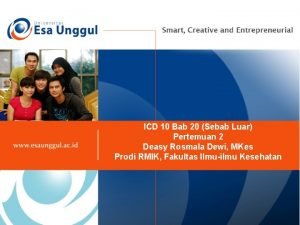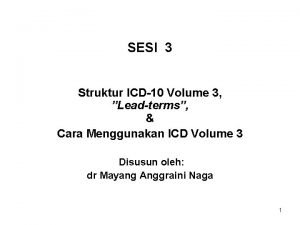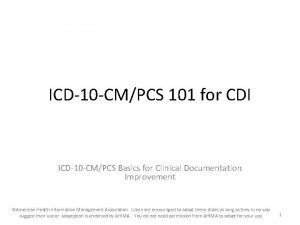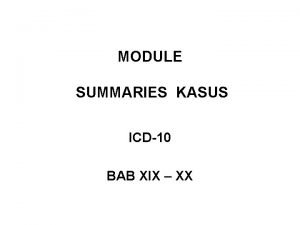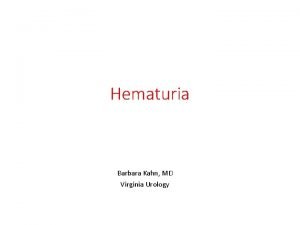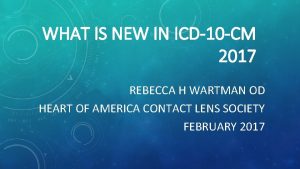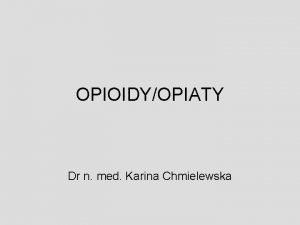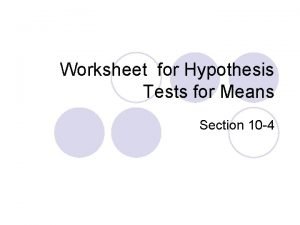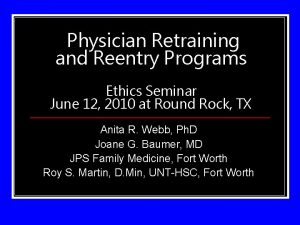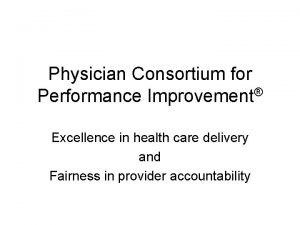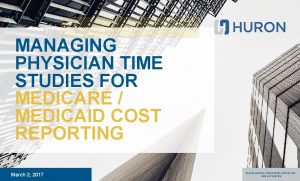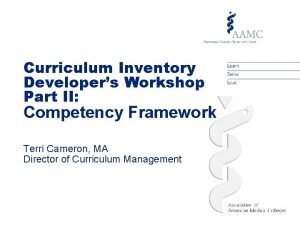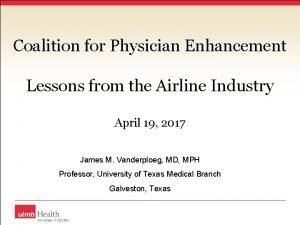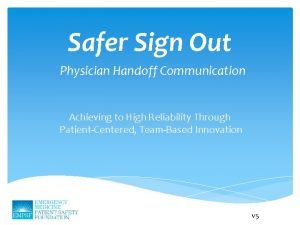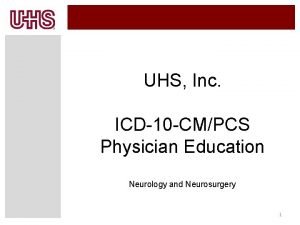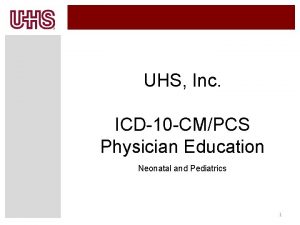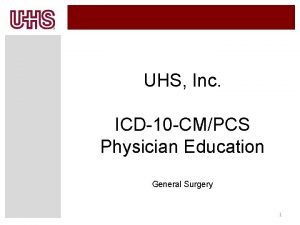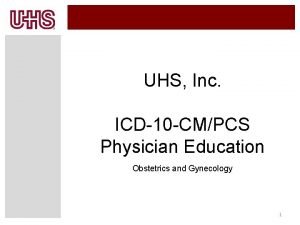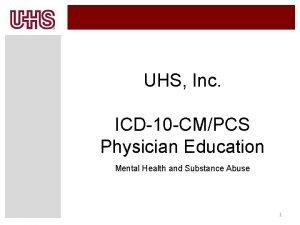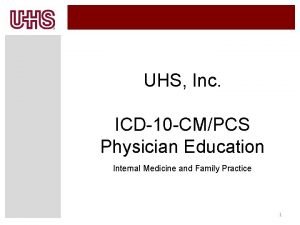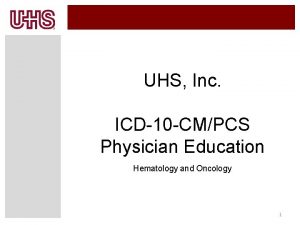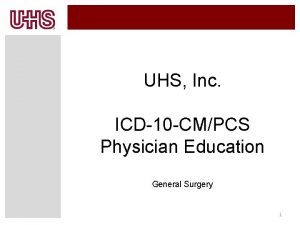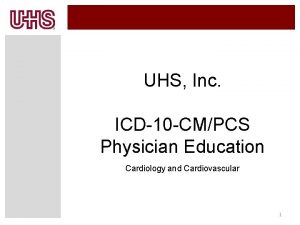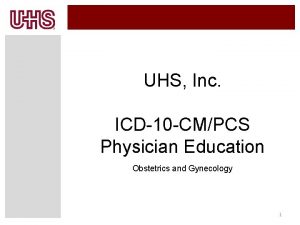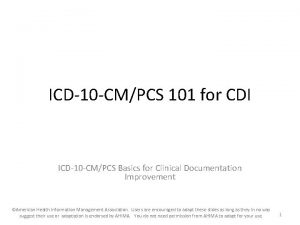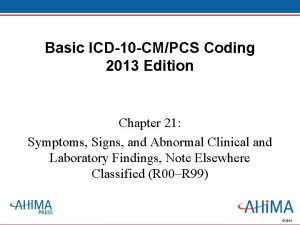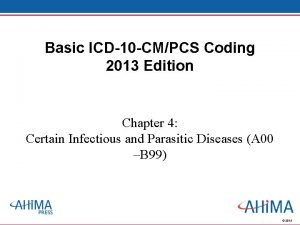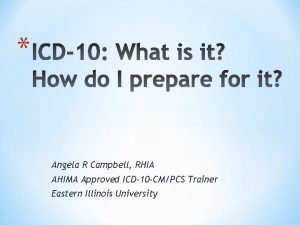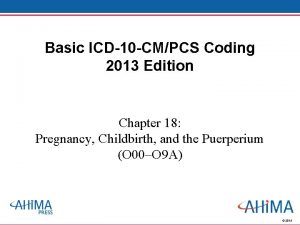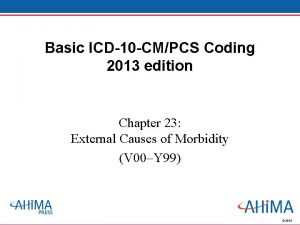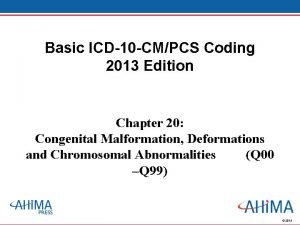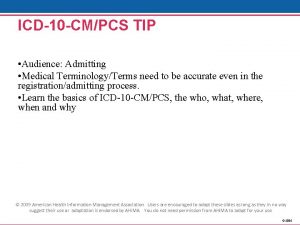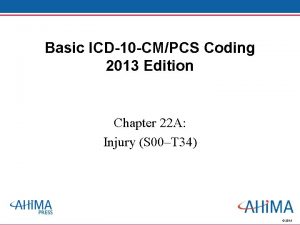UHS Inc ICD10 CMPCS Physician Education Orthopaedics 1
































- Slides: 32

UHS, Inc. ICD-10 -CM/PCS Physician Education Orthopaedics 1

ICD-10 Implementation • October 1, 2015 – Compliance date for implementation of ICD-10 -CM (diagnoses) and ICD-10 -PCS (procedures) – Ambulatory and physician services provided on or after 10/1/15 – Inpatient discharges occurring on or after 10/1/15 • ICD-10 -CM (diagnoses) will be used by all providers in every health care setting • ICD-10 -PCS (procedures) will be used only for hospital claims for inpatient hospital procedures – ICD-10 -PCS will not be used on physician claims, even those for inpatient visits 2

Why ICD-10 Current ICD-9 Code Set is: – Outdated: 30 years old – Current code structure limits amount of new codes that can be created – Has obsolete groupings of disease families – Lacks specificity and detail to support: • Accurate anatomical positions • Differentiation of risk & severity • Key parameters to differentiate disease manifestations 3

Diagnosis Code Structure 4

ICD-10 -CM Diagnosis Code Format 5

Comparison: ICD-9 to ICD-10 -CM 6

Procedure Code Structure

ICD-10 -PCS Code Format 8

ICD-10 Changes Everything! • ICD-10 is a Business Function Change, not just another code set change. • ICD-10 Implementation will impact everyone: – Registration, Nurses, Managers, Lab, Clinical Areas, Billing, Physicians, and Coding • How is ICD-10 going to change what you do? 9

ICD-10 -CM/PCS Documentation Tips 10

ICD-10 Provider Impact • Clinical documentation is the foundation of successful ICD 10 Implementation • Golden Rule of Documentation – If it isn’t documented by the physician, it didn’t happen – If it didn’t happen, it can’t be billed • The purpose in documentation is to tell the story of what was performed and what is diagnosed accurately and thoroughly reflecting the condition of the patient – what services were rendered and what is the severity of illness • The key word is SPECIFICITY – Granularity – Laterality • Complete and concise documentation allows for accurate coding and reimbursement 11

Gold Standard Documentation Practices 1. Always document diagnoses that contributed to the reason for admission, not just the presenting symptoms 2. Document diagnoses, rather that descriptors 3. Indicate acuity/severity of all diagnoses 4. Link all diseases/diagnoses to their underlying cause 5. Indicate “suspected”, “possible”, or “likely” when treating a condition empirically 6. Use supporting documentation from the dietician / wound care to accurately document nutritional disorders and pressure ulcers 7. Clarify diagnoses that are present on admission 8. Clearly indicate what has been ruled out 9. Avoid the use of arrows and symbols 10. Clarify the significance of diagnostic tests 12

ICD-10 Provider Impact The 7 Key Documentation Elements: 1. Acuity – acute versus chronic 2. Site – be as specific as possible 3. Laterality – right, left, bilateral for paired organs and anatomic sites 4. Etiology – causative disease or contributory drug, chemical, or non-medicinal substance 5. Manifestations – any other associated conditions 6. External Cause of Injury – circumstances of the injury or accident and the place of occurrence 7. Signs & Symptoms – clarify if related to a specific condition or disease process 13

ICD-10 Documentation Tips Do not use symbols to indicate a disease. For example “↑lipids” means that a laboratory result indicates the lipids are elevated – or “↑BP” means that a blood pressure reading is high These are not the same as hyperlipidemia or hypertension 14

ICD-10 Documentation Tips Site and Laterality – right versus left –bilateral body parts or paired organs Example – cellulitis of right upper arm Stage of disease – acute vs. chronic vs. acute on chronic Example – stage of pressure ulcer: – L 89. 011 Pressure ulcer of right elbow, stage 1 – L 89. 021 Pressure ulcer of left elbow, stage 1 Episode of care – initial, subsequent, and sequelae Example - lower leg fracture: A initial encounter for closed fracture B initial encounter for open fracture type I or II C initial encounter for open fracture type IIIA, IIIB, or IIIC D subsequent encounter for closed fracture with routine healing H subsequent encounter for open fracture type I or II with delayed healing – K subsequent encounter for closed fracture with nonunion – S sequelae 15 – – –

ICD-10 Documentation Tips Fractures – clearly document all aspects – Cause – traumatic, stress, pathological – Location – which bone, where on the bone, laterality – Type – compound, delayed, union, depressed, elevated, greenstick, impacted, oblique, etc. • If open – use Gustilo classification – Displacement – displaced or non-displaced – Encounter – initial, subsequent, sequelae • Healing process – routine aftercare, delayed, nonunion, malunion – External cause – how the fractured occurred and the activity • Example - Fall while skiing 16

ICD-10 Documentation Tips Open fractures - Please specify the severity using the Gustilo-Anderson Open Fracture Classification system forearm, femur, and lower leg – Type I: The wound is smaller than 1 cm, clean, and generally caused by a fracture fragment that pierces the skin (i. e. , inside-out injury). – Type II: The wound is longer than 1 cm, not contaminated, and without major soft tissue damage or defect. This is also a low-energy injury. – Type III: The wound is longer than 1 cm, with significant soft tissue disruption. The mechanism often involves high-energy trauma, resulting in a severely unstable fracture with varying degrees of fragmentation. – Type III fractures are further divided into • III A: Soft tissue coverage of the fractured bone is adequate. • III B: Disruption of the soft tissue is extensive, that local or distant flap coverage is necessary. • III C: Any open fracture that is associated with an arterial injury that a physician must repair, regardless of the degree of soft tissue injury. 17

ICD-10 Documentation Tips Pathologic (non-traumatic) fractures: – Exact location of fracture – • Bone, part of the bone, and laterality – Etiology of the fracture – • osteoporosis, neoplastic disease, drug induced – Encounter type – • initial encounter, subsequent encounter with routine healing, subsequent encounter with delayed healing, malunion, nonunion, or sequelae – Healing status – • Routine, delayed, nonunion, malunion • Any past history of healed pathological fractures 18

ICD-10 Documentation Tips Arthropathies • Type –Traumatic –Infectious – document specific organism • Site – include laterality (right, left, bilateral) • Link underlying or associated conditions –Bone changes related to DM • Examples: –Traumatic arthropathy, left shoulder –Arthropathy following intestinal bypass, left shoulder 19

ICD-10 Documentation Tips Bursa Disorders • Type –Bursitis –Bursopathy • Abscess of bursa • Infective bursitis • Synovial cyst • Bursal cyst • Calcium deposit • Site – bursa affected and laterality (right, left, bilateral) • Link underlying or associated conditions –Activity causing the disorder –Related to use, overuse, pressure, post-procedural complication –Rupture of synovial or bursa cyst 20

ICD-10 Documentation Tips Osteomyelitis • Site – include laterality (right, left, bilateral) • Severity / Type –Acute, chronic, subacute –Hematogenous • Link underlying or associated conditions –Multifocal osteomyelitis –With or without draining sinus –Chronic hematogenous –Major osseous defect • Document if any associated injury is current or old 21

ICD-10 Documentation Tips Osteoarthritis • Site – joint affected – include laterality (right, left, bilateral) • Severity / Type –Acute, chronic, subacute –Hematogenous • Link underlying or associated conditions –Presence or absence of hip dysplasia –Polyosteoarthritis • Document if any associated injury is current or old –Primary, secondary, or post-traumatic 22

ICD-10 Documentation Tips Rheumatoid Arthritis • Site • Laterality • Link manifestations –With or without Rheumatoid Factor –Felt’s syndrome –Rheumatoid lung disease –Rheumatoid vasculitis –Rheumatoid heart disease –Rheumatoid polyneuropathy –With involvement of other organs or systems 23

ICD-10 Documentation Tips Drug Under-dosing is a new code in ICD-10 -CM. – It identifies situations in which a patient has taken less of a medication than prescribed by the physician. • Intentional versus unintentional – Documentation requirements include: • The medical condition • The patient’s reason for not taking the medication – example – financial reason – Z 91. 120 – Patient’s intentional underdosing of medication due to financial hardship 24

ICD-10 Documentation Tips Cause of Injury – Mechanism • How it happened – Place of occurrence • Where it happened – Activity • What was the patient doing – External Cause • Work-related, leisure 25

ICD-10 Documentation Tips Glasgow Coma - ICD-10 -CM coding will need the score from each of the assessment areas – Eye opening – Verbal response – Motor response » » R 40. 211 Coma scale, eyes open never R 40. 212 Coma scale, eyes open to pain R 40. 213 Coma scale, eyes open to sound R 40. 214 Coma scale, eyes open spontaneously –Report the Glasgow coma scale total score » R 40. 241 Glasgow coma scale score 13 – 15 » R 40. 242 Glasgow coma scale score 9 - 12 » R 40. 243 Glasgow coma scale score 3 – 8 26

ICD-10 Documentation Tips Codes for postoperative complications have been expanded and a distinction made between intraoperative complications and postprocedural disorders • The provider must clearly document the relationship between the condition and the procedure – Example: • D 78. 01 –Intraoperative hemorrhage and hematoma of spleen complicating a procedure on the spleen • D 78. 21 –Post-procedural hemorrhage and hematoma of spleen following a procedure on the spleen 27

ICD-10 Documentation Tips Intra-operative Post-procedural Accidental puncture / laceration Timing: • Post-procedure • Late effect Same or different body system Classify as: • An expected post-procedural condition • An unexpected post-procedural condition, related to the patient’s underlying medical comorbidities • An unexpected post-procedural condition, unrelated to the procedure • An unexpected post-procedural condition related to surgical care (a complication of care) Blood product Central venous catheter Drug: • What adverse effect • Drug name • Correctly prescribed • Properly administered Encounter: • Initial • Subsequent • Sequelae 28

ICD-10 Documentation Tips ICD-10 -PCS does not allow for unspecified procedures, clearly document: • Body System – general physiological system / anatomic region • Root Operation – objective of the procedure • Body Part – specific anatomical site • Approach – technique used to reach the site of the procedure • Device – Devices left at the operative site

ICD-10 Documentation Tips Most Common Root Operations: Detachment – cutting off all or part of the upper or lower extremity Fusion – joining together portions of an articular body part, rendering the body part immobile Replacement – putting in or on a biological or synthetic material that takes the place &/or function Transfer – moving, without taking out, all of a portion of a body part to another location Division – cutting into a body part without draining fluids &/or gases in order to separate / transect the body part Reattachment – Reposition – moving to its normal location putting back in or other suitable location a body part all or a portion of a separated body part Drainage – taking or Repair – restoring, to Supplement – putting in or on biological or letting out fluids &/or the extent possible, synthetic material that physically gases a body part to its reinforces &/or augments function normal function 30

ICD-10 Documentation Tips Approaches: External Via Natural or Artificial Opening Open Via Natural or Artificial Opening Endoscopic Percutaneous Via Natural or Artificial Opening Endoscopic with Percutaneous Endoscopic Assistance Percutaneous Endoscopic 31

Summary The 7 Key Documentation Elements: 1. Acuity – acute versus chronic 2. Site – be as specific as possible 3. Laterality – right, left, bilateral for paired organs and anatomic sites 4. Etiology – causative disease or contributory drug, chemical, or non-medicinal substance 5. Manifestations – any other associated conditions 6. External Cause of Injury – circumstances of the injury or accident and the place of occurrence 7. Signs & Symptoms – clarify if related to a specific condition or disease process 32
 Icd-10 orthopaedics
Icd-10 orthopaedics Slab vs splint
Slab vs splint Uva presentation template
Uva presentation template Uva orthopaedics
Uva orthopaedics Uhs biomed
Uhs biomed Uhs
Uhs Uhs cwru
Uhs cwru Uhs pulmonology
Uhs pulmonology Sonya borrell
Sonya borrell Uhs hematology
Uhs hematology Kode icd 10 tertabrak kereta api
Kode icd 10 tertabrak kereta api Kode icd 10 otitis media kronik
Kode icd 10 otitis media kronik Icd kecelakaan lalu lintas
Icd kecelakaan lalu lintas Isi volume 3 icd-10 adalah
Isi volume 3 icd-10 adalah Cdi icd 10
Cdi icd 10 Icd 10 code for allergic reaction to peanuts
Icd 10 code for allergic reaction to peanuts Icd10 sungsang
Icd10 sungsang Isrr icd10
Isrr icd10 Microhematuria icd 10
Microhematuria icd 10 Crvo icd10
Crvo icd10 Opioidy
Opioidy A physician claims that joggers maximum volume
A physician claims that joggers maximum volume Physician reentry programs
Physician reentry programs Physician consortium for performance improvement
Physician consortium for performance improvement Physician time study
Physician time study Hcp segmentation
Hcp segmentation Physician competency reference set
Physician competency reference set Coalition for physician enhancement
Coalition for physician enhancement Physician associate lecturer
Physician associate lecturer Physician sign out
Physician sign out Elisha goodman
Elisha goodman Colorado physicians health program
Colorado physicians health program Physician burnout retreat
Physician burnout retreat

